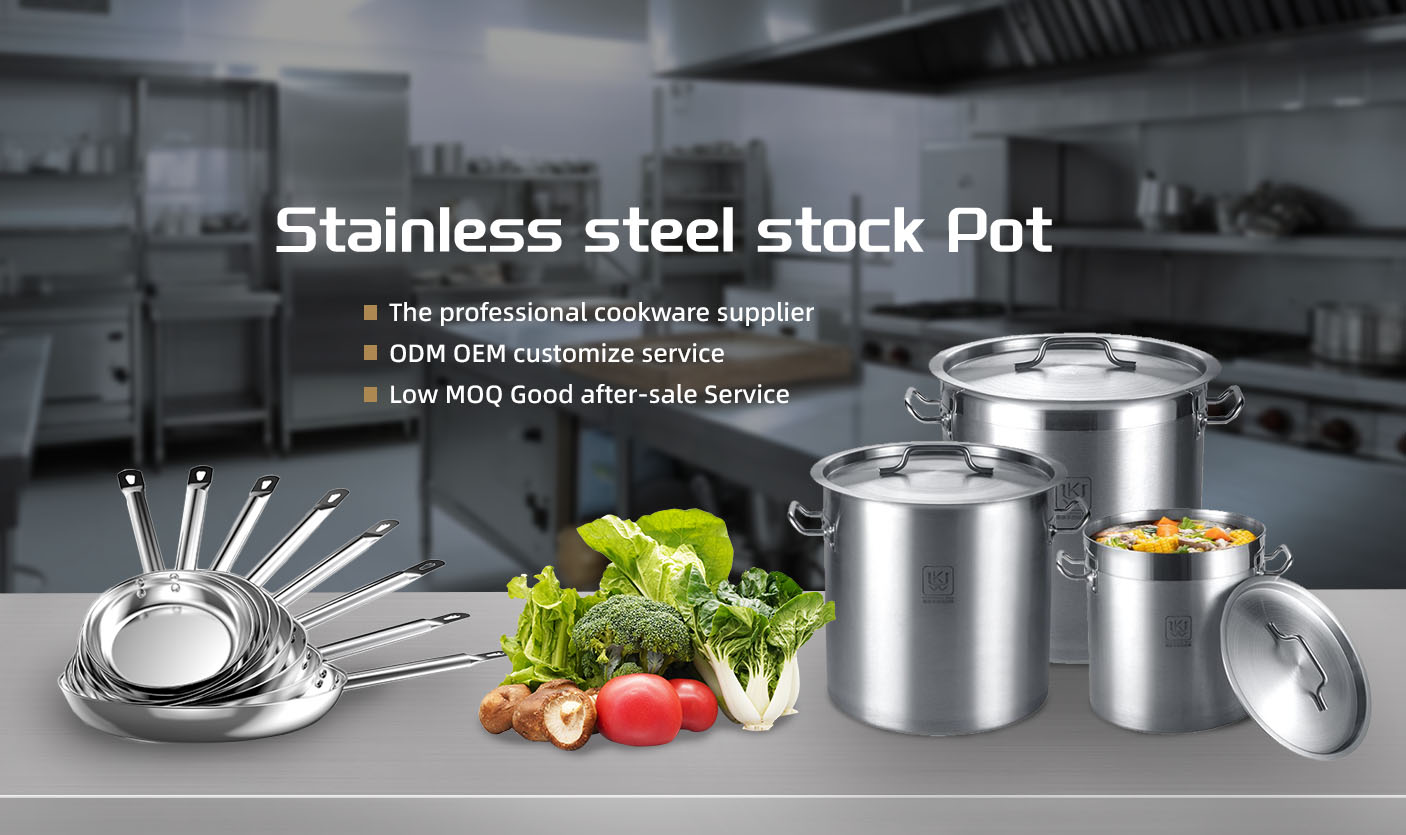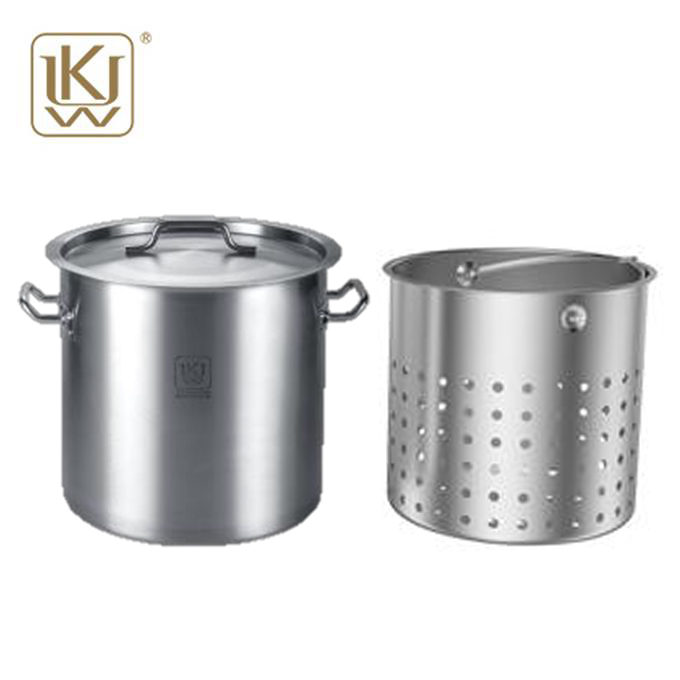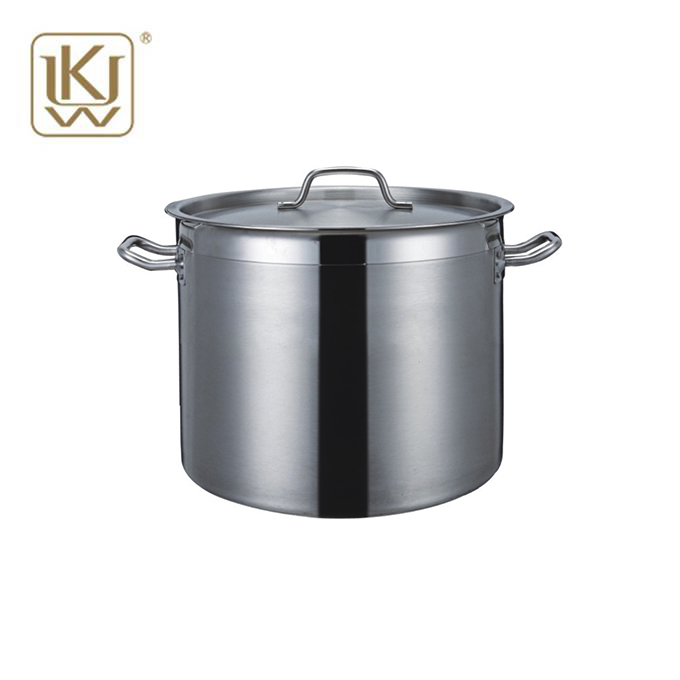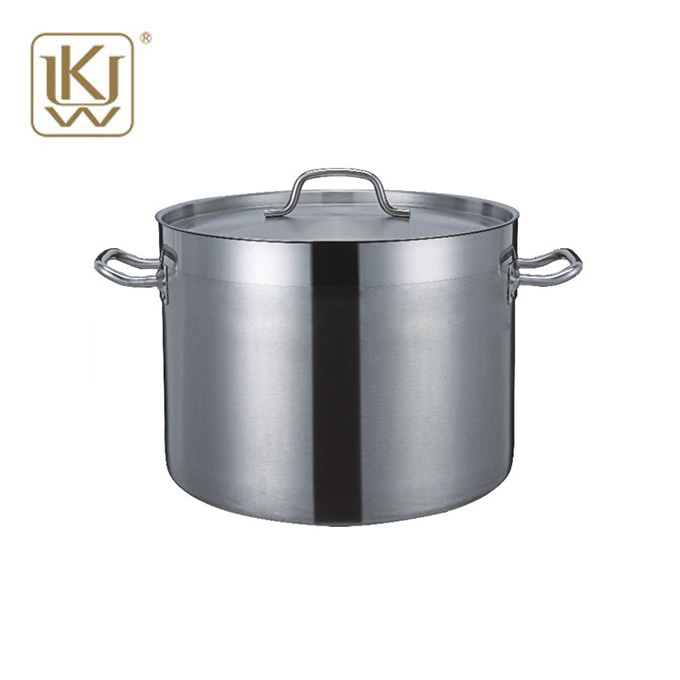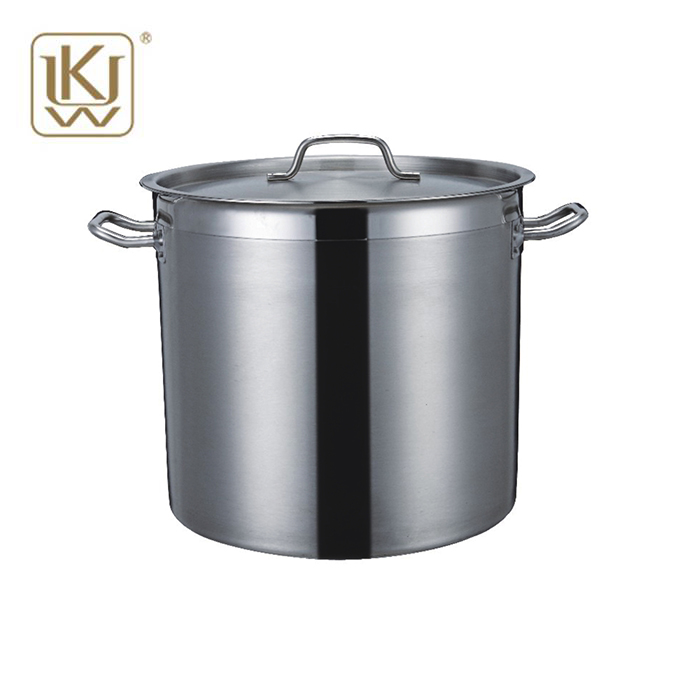Large Stainless Steel Soup Pot
- Product Information
The Large stainless steel soup pot is a kitchen essential designed for efficient cooking and storage of large amounts of liquids and ingredients. It is made of high-quality 304 stainless steel with excellent corrosion resistance and antioxidant properties. The soup pot offers a variety of capacity options from 6L to 170L to meet the needs of different scenarios such as home, restaurant, and hotel. Its cylindrical structure and suitable height not only facilitate deep cooking, but also reduce liquid evaporation and keep the original flavor of food. The equipped lid and two side handles make it easy to carry and operate, while effectively locking in the aroma of food. Users can use it to cook soup, stew meat, cook pasta, and even cook large quantities, such as preparing food for family gatherings or restaurants. It can easily cope with it.
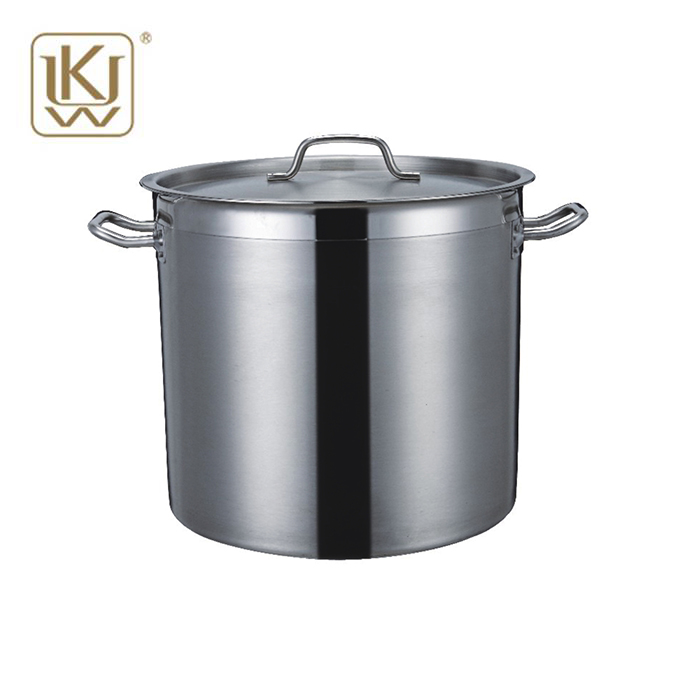
large stainless steel soup pot Parameters:
| CODE 05 STYLE | Dimension | VOLUME | BODY & LID THICK(mm) | ALUMINUM THICK(mm) |
| SP202005 | Ф200*H200 | 6L | 0.8 | 4 |
| SP252505 | Ф250*H250 | 12L | 0.8 | 4 |
| SP282805 | Ф280*H280 | 17L | 0.8 | 4 |
| SP303005 | Ф300*H300 | 21L | 0.8 | 4 |
| SP323205 | Ф320*H320 | 25L | 0.8 | 4 |
| SP363605 | Ф360*H360 | 36L | 1 | 4 |
| SP404005 | Ф400*H400 | 50L | 1 | 4 |
| SP454505 | Ф450*H450 | 71L | 1 | 4 |
| SP505005 | Ф500*H500 | 98L | 1 | 5 |
| SP555505 | Ф550*H550 | 130L | 1 | 5 |
| SP606005 | Ф600*H600 | 170L | 1 | 5 |
Large Stainless Steel Soup Pot Features:
1. High-quality stainless steel
The large stainless steel soup pot is made of 304 stainless steel, which contains 18% chromium and 8% - 10% nickel, giving it excellent corrosion resistance and antioxidant properties. In the simulated kitchen acid-base environment test, 304 stainless steel has 10 - 15 times higher corrosion resistance than ordinary carbon steel. Even if it is exposed to acidic tomato soup or alkaline detergents for a long time, the surface of the soup pot remains as bright and clean as new. Its tensile strength reaches 520 - 760 MPa, which is far higher than ordinary steel, ensuring that the pot body is not easily deformed during repeated heating, cooling and collision, and it is stress-free to carry food weighing up to 20kg, with a service life of up to 10 - 15 years.
2. Multiple practical capacities
The soup pot offers a variety of capacity options from 6L to 170L to meet the needs of different scenarios. For example, for daily family use, you can choose 12-25L specifications (250-320mm diameter, 250-320mm height), which can cook 5-10kg of ingredients at a time, suitable for 3-8 people. Large catering venues are suitable for 71-170L specifications (450-600mm diameter, 450-600mm height), which can cook 20-100kg of ingredients at a time and efficiently complete batch cooking tasks. This diverse capacity design ensures that users can find the right soup pot in different cooking scenarios, improving cooking efficiency and flexibility.
3. Precise size design
The soup pot has a diameter of 200mm to 600mm and a height of 200mm to 600mm, forming a variety of specifications. Take the 21L specification with a diameter of 300mm and a height of 300mm as an example. It is suitable for medium-sized family gatherings and can cook soup for 8-10 people. The pot has ample space inside, so the ingredients can be fully rolled during cooking and heated evenly. The precise size design can also effectively utilize the stove area and kitchen storage space. Whether it is placed on a gas stove, induction cooker or stored in a cabinet, it looks neat and tidy. This design not only improves the convenience of cooking, but also optimizes the utilization of kitchen space.
4. Excellent durability
The thickness of the pot body and lid of the soup pot is 0.8-1mm, far exceeding the industry standard of 0.5-0.6mm. Taking the thickness of 0.8mm as an example, its wear resistance is 30%-40% higher than that of ordinary soup pots, and it is not easy to have scratches, dents and other problems under high-intensity use. After more than 10,000 heating-cooling cycle tests, the deformation of the soup pot is controlled within a very small range, and it still maintains good sealing and cooking performance. Even in the high-intensity environment of 8-10 hours a day in commercial kitchens, it can be used continuously for 5-8 years. This excellent durability reduces the frequency of replacement and saves long-term use costs.
5. Stable structural design
The soup pot is equipped with two sturdy side handles, which are made of the same 304 stainless steel as the pot body and connected to the pot body through laser welding technology. The tensile strength of the welding point reaches 350-400 MPa, which can easily bear the weight of the pot body and ingredients. The arc design of the handle is ergonomic and comfortable to hold. The surface is anti-slip and the friction coefficient reaches 0.5-0.6, which can be firmly held even with gloves. When carrying a soup pot full of ingredients, it can effectively prevent slipping and falling off, ensuring safe operation. This stable design not only improves the convenience of use, but also enhances safety during cooking.
6. Uniform heating
304 stainless steel has good thermal conductivity. With the cylindrical design of the soup pot, heat can be quickly and evenly transferred from the bottom of the pot to the entire pot body. During the soup cooking process, the temperature difference in the pot is controlled within the range of ±2℃. Compared with the temperature difference of ±5℃ of ordinary soup pots, the ingredients are heated more evenly. For example, to boil 10L of water, an ordinary soup pot takes 12-15 minutes, and the bottom may overheat and the edges may not boil; this soup pot only takes 10-12 minutes, and the water temperature in the entire pot rises synchronously, ensuring that the ingredients are evenly heated and taste better. This uniform heating performance improves the cooking quality and makes the food more delicious.
7. Good sealing
The lid of the soup pot is uniquely designed and fits tightly with the pot body. The edge of the lid is thickened, and the sealing rubber ring is made of food-grade silicone, which is resistant to high temperatures of 200℃ and can effectively prevent steam leakage during the cooking process. According to tests, when boiling 15L of soup, the amount of steam leakage in the pot is reduced by 60%-70% compared with an ordinary soup pot, which not only keeps the original flavor of the food, but also shortens the cooking time by 15%-20%. For example, stewing beef soup may take 2-2.5 hours in an ordinary soup pot, and the soup will lose 30%-40%; while this soup pot only takes 1.5-2 hours, and the soup loss is less than 10%, and the nutrition and flavor of the ingredients are fully preserved. Good sealing ensures the quality and taste of the food.
8. Strong antioxidant performance
The high chromium and nickel content of 304 stainless steel gives the soup pot excellent antioxidant properties. Under high-temperature cooking conditions, its antioxidant capacity is 8-10 times higher than that of ordinary carbon steel. After long-term use, the surface of the pot remains bright and there is no obvious oxidation mark. When cooking meat or seafood rich in fat, there will be no oxidation spots or coating shedding on the inner wall of the pot, ensuring food safety and hygiene. This strong antioxidant performance extends the service life of the soup pot, reduces maintenance costs, and provides users with long-term and reliable use guarantees.
Large Stainless Steel Soup Pot Application:
1. Home kitchen
In the home kitchen, the Large Stainless Steel Soup Pot is a great helper for cooking traditional food and hosting family dinners. Take the cooking of Cantonese-style cured meat clay pot rice as an example. Using a 17L soup pot with a diameter of 280mm and a height of 280mm, 4-6 servings of clay pot rice can be cooked at the same time. Soak the sausage, cured meat and other ingredients in advance, put them into the pot together with the rice, and add an appropriate amount of water. The sealing performance of the soup pot ensures that the water will not evaporate excessively during the cooking process, and the rice fully absorbs the aroma of the cured meat. The rice grains are distinct, and a layer of golden and crispy rice crust forms at the bottom, adding deliciousness to family dinners. This efficient cooking ability makes home cooking easier and more enjoyable.
2. Restaurant kitchen
In the restaurant kitchen, the soup pot is a key tool for efficient meal delivery. Take a Chinese restaurant that receives 200-300 guests a day as an example. The kitchen uses a 50L soup pot with a diameter of 400mm and a height of 400mm to make the signature pickled fish. Before the meal every day, the chef prepares the fish fillets, pickled cabbage and other ingredients according to the amount and puts them into the soup pot. The uniform heat conductivity of the soup pot ensures that each portion of pickled fish is quickly cooked within 3-5 minutes, the fish is tender and the soup is sour and refreshing. Even during peak hours, it can ensure that every table of guests can enjoy the steaming hot and consistent quality dishes in time. This efficient cooking performance has significantly improved the restaurant's operating efficiency and customer satisfaction.
3. Hotel kitchen
Hotel kitchens need to cope with the needs of various large banquets and buffets, and Large Stainless Steel Soup Pot plays an important role in this. Take a five-star hotel that hosts a wedding banquet for 500 people as an example. The chef team uses a 98L soup pot with a diameter of 500mm and a height of 500mm to cook Buddha Jumps Over the Wall at the wedding banquet. Abalone, sea cucumber, fish maw and other high-end ingredients are processed and stewed separately in advance, and then put into the soup pot according to the proportion. The durability and large capacity of the soup pot can accommodate all ingredients and broth. After 4-6 hours of slow stewing, the Buddha Jumps Over the Wall soup is rich and mellow, and the ingredients are soft and tasty, bringing guests the ultimate taste enjoyment. This high-quality cooking effect has improved the hotel's catering service level and competitiveness.
4. Food processing plant
In the field of food processing, soup pots are used to make various pre-prepared foods. Take the factory that produces quick-frozen dumplings as an example. 500-1000kg of dumplings need to be processed every day. The factory uses a 130L soup pot with a diameter of 550mm and a height of 550mm for cooking. The precise size and large capacity of the soup pot enable it to cook 30-50kg of dumplings at a time. With the automated production line, the dumplings are cooked, cooled and packaged within 8-10 minutes. The antioxidant properties of the soup pot ensure that the water quality is not polluted during the long and high-temperature cooking process, the dumpling skin remains chewy, and the filling is delicious and juicy. This efficient production capacity and stable quality assurance enable food processing plants to meet market demand and improve production efficiency and product quality.
5. Charity kitchens
Charity kitchens require a large amount of cooking equipment to prepare free meals. For example, a charity kitchen that provides meals for 200-300 poor people every day uses a 170L soup pot with a diameter of 600mm and a height of 600mm to make large pot dishes. The soup pot's stable structure and handle design make it easy for volunteers to carry and distribute food. Even in the case of limited resources, the soup pot's large capacity and efficient cooking performance can quickly provide recipients with hot and delicious meals, such as stewed potato beef soup and vegetable stew, to meet people's nutritional needs. This reliability and efficiency ensure that charities can continue to provide support to people in need.
6. Community center kitchens
Community center kitchens provide residents with a variety of cooking courses and activities. Taking the cooking training course as an example, the instructor used a 36L soup pot with a diameter of 360mm and a height of 360mm to demonstrate the traditional method of making beef stewed with radish. The uniform heating performance of the soup pot ensures that the beef is evenly heated during the stewing process and the radish is soft and tasty. By observing the instructor's operation, the trainees can intuitively learn skills such as heat control and ingredient matching. The durability and easy cleaning of the soup pot keep it in good condition during frequent teaching use, providing community residents with a high-quality cooking learning experience. This versatility and reliability enable the community center to better serve residents and promote the harmonious development of the community.
Large Stainless Steel Soup Pot Maintenance:
1. Cleaning and Maintenance
After use, wait for the Large Stainless Steel Soup Pot to cool naturally to a warm state before cleaning. First, use a soft brush and warm water to remove the remaining food particles in the pot. For stubborn stains, use a stainless steel special cleaner, dilute the detergent to water in a ratio of 1:5 and wipe it. Avoid using strong acidic or alkaline cleaners to avoid corrosion of the pot body. When cleaning the pot lid, gently wipe the sealing rubber ring to prevent damage to its shape and performance. After cleaning, rinse thoroughly with clean water and wipe the inside and outside surfaces of the pot with a soft cloth. For example, after stewing soup containing tomato sauce, acidic stains may remain in the pot. Timely cleaning with a special cleaner can effectively remove the stains and keep the pot clean. This meticulous cleaning and maintenance measures ensure the long-term performance and hygienic safety of the soup pot.
2. Storage and Maintenance
Store the soup pot in a dry, ventilated cabinet to avoid humid environments that cause oxidation of the pot body. When storing, place moisture-proof paper between the pot and the lid to absorb excess moisture. If it is not used for a long time, a thin layer of cooking oil can be applied to the pot to prevent moisture and oxygen in the air from contacting the pot body and causing rust. For example, in kitchens in coastal areas, the air humidity is high and the salt content is high. Storing the soup pot according to the above method can effectively extend its service life and prevent rust. This scientific storage method ensures that the soup pot can remain in good condition during non-use and is ready for use at any time.
3. Avoid collision
During kitchen operation and transportation, be careful to place the soup pot gently to avoid collision with hard objects. If you need to carry it from the stove to the dining table, hold the handles on both sides with both hands to keep the pot stable. If the soup pot accidentally falls or is hit, check whether the pot body is deformed or scratched in time. Once deformation is found, it will affect the uniformity of heating and sealing of the soup pot, and it should be repaired or replaced in time. For example, in a fast-paced restaurant kitchen, if the waiter accidentally hits the soup pot during the delivery process, it may cause dents on the edge of the pot, affecting the cooking effect and appearance. Through careful operation and timely inspection, damage caused by accidental collisions can be avoided and the service life of the soup pot can be extended.
4. Check the sealing rubber ring regularly
Check the status of the lid sealing rubber ring every 1-2 months. Check whether the rubber ring is aging, deformed, cracked, etc. If fine cracks are found on the surface of the rubber ring, it needs to be replaced in time to ensure the sealing performance of the soup pot. When cleaning the rubber ring, you can use a soft-bristled toothbrush dipped in a small amount of alcohol to gently scrub it to remove surface oil and bacteria. For example, if you cook soup with grease for a long time, the rubber ring is prone to accumulate oil and affect the sealing effect. Regular cleaning and inspection can ensure that the soup pot maintains good sealing and reduce the heat and aroma loss during cooking. This regular maintenance measure ensures the sealing performance and cooking effect of the soup pot, and improves the reliability and satisfaction of use.
5. Prevent empty burning
When cooking, make sure there is enough liquid or ingredients in the pot before turning on the fire to avoid empty burning. Empty burning will cause the temperature of the pot body to rise rapidly, causing irreversible oxidation and deformation of the stainless steel material, affecting the service life and performance of the soup pot. If the soup pot is empty due to negligence, turn off the fire immediately, let the pot body cool naturally, and then check whether the bottom of the pot is damaged. For minor discoloration of the pot bottom, you can wipe it with stainless steel cleaning paste; if there is severe deformation or perforation, the soup pot needs to be replaced. For example, if the liquid is accidentally boiled dry during soup cooking, the bottom of the pot may appear partially red, bulging, etc. At this time, you need to follow the above steps to avoid further damage. By preventing empty cooking, you can effectively protect the soup pot, extend its service life, and ensure the safety and smoothness of the cooking process.
6. Use cleaning tools gently
When cleaning the Large Stainless Steel Soup Pot, choose a soft brush, sponge or wooden cleaning tool, and avoid using abrasive tools such as steel wool and hard scouring pads. Steel wool will scratch the surface of the pot during the cleaning process, destroy the protective layer of stainless steel, and accelerate the oxidation of the pot. For stubborn stains, you can soak it in hot water for 10-15 minutes to soften the stains and then gently scrub it with a soft brush. For example, after cooking a soup containing a lot of protein, stubborn protein residue may appear in the pot. Soaking it in hot water and then cleaning it with a soft brush can effectively remove the residue, keep the pot clean, and extend the service life of the soup pot. This gentle cleaning method not only protects the surface of the soup pot, but also ensures the cleaning effect, so that the soup pot always remains in good condition.
Large Stainless Steel Soup Pot FAQ?
Is a Large Stainless Steel Soup Pot suitable for induction cooking?
Yes, most Large Stainless Steel Soup Pots are compatible with induction cooktops. Stainless steel is magnetic, which is necessary for induction cooking, allowing the pot to heat quickly and evenly on an induction stove.
What are the benefits of a tight-fitting lid on a Large Stainless Steel Soup Pot?
A tight-fitting lid on a stock pot helps to retain heat and moisture, which is essential for enhancing flavors and maintaining the tenderness of your dishes. It also prevents spills and reduces the risk of boil-overs, making cooking more efficient and mess-free.
Can you use a Large Stainless Steel Soup Pot for deep frying?
Yes, a Large Stainless Steel Soup Pot can be used for deep frying. Its tall sides help contain the oil, reducing splatter, and its even heat distribution ensures that the oil maintains a consistent temperature, which is crucial for perfect frying results.


